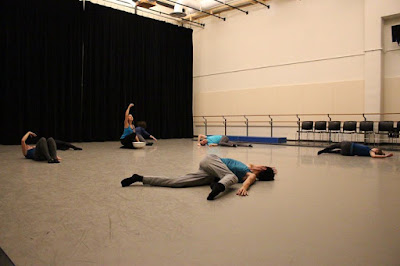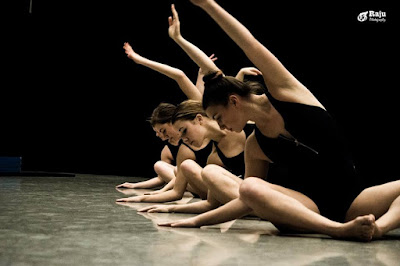This week, we'll be hearing some thoughts from Claire Penning, a junior Dance and Elementary Education double major from Winona, MN, and Ivy Boudreau, a junior Dance major and Psychology minor from Stevens Point, WI.
MEET CLAIRE
Where did you find the inspiration for your concept?
The main inspiration for me
piece came from my cousin’s baby boy. We were at a wedding and it was
beautiful to watch him look around at everything and everybody with such
an innocence and awe in his eyes. He made me
think about what is what to be a child and how much I have grown since
then.
What style is your piece? How many dancers are in the piece?
My piece is mainly modern
based, but with very pedestrian movements. I have seven beautiful
dancers in my piece and they have brought my ideas and vision to life.
What are some strategies you use during the rehearsal process?
It was mainly a trial and
error process. I would start a small phrase and then build off of it.
Sometimes I really liked where it went, while other times I would
scratch it and try something else. My dancers were always
open to trying any material; they made the creation of my piece fun and
I looked forward to working with them at every rehearsal.
How have you grown as an artist through the process of creating a new piece of choreography?
I have learned to trust my
instincts and myself. There were times when I really wanted a phrase to
work, but it was not fitting with the rest of my piece, so I had to let
it go.
How does one of your "typical" rehearsals work?
We start off reviewing any
material that needed to be clarified or was changed in the last
rehearsal, from there we run the piece one or two times and then slight
adjustments are made. From there we would typically
learn new choreography and run the piece probably two more times before
rehearsal ended.
MEET IVY
Where did you find the inspiration for your concept?
All my life, I've loved water and felt a strong connection to it. Even though its power is absolutely terrifying, there is a beauty in something that can be so gentle and peaceful, but is also completely unpredictable and could kill you. I began thinking about water and more specifically the ocean as a metaphor for the human mind, and from there, my cast and I began to uncover sets of polarities and single ideas that are true of both the ocean and the mind. Both have an ebb and flow between sound and silence, oppression and liberation, showing love and compassion and being blindly cruel, and both have mysterious depths that will probably never be truly reached.
What style is your piece? How many dancers are in the piece?
The style of my piece is modern, and there are seven dancers, plus myself. I have such a fantastic cast - they've been engaged and helpful and full of ideas and creativity and good energy at every step of the way, and I couldn't have done it without them.
What are some strategies you use during the rehearsal process?
For our first few rehearsals, we worked a lot with improvisation to figure out how to embody the idea of water - not just being in water, but also being water. We also spent time brainstorming connections between the ocean and the mind, writing them on the whiteboard in the studio, and then using these words as prompts for improvisation so that we could begin to feel these ideas in our bodies and movements. I also sometimes taught my cast a phrase and then asked them to create a new, brief phrase using a few movements or gestures from the original phrase, which I then used to developed new variations on the theme of our original phrase. All of this allowed us to really work together and collaborate as a group - since the work is about the mind, I really wanted it to contain the ideas and inspirations of many different minds.
How have you grown as an artist through the process of creating a new piece of choreography?
I have gained so much confidence in trusting my instincts as an artist and listening to that little voice deep inside that pushes me in the right direction. I've also learned to never let myself off the hook - if something in the work felt "off" or didn't make sense or bothered me in some way, I always took the time to figure out why it wasn't working and how I could change it so that it more accurately conveyed the information I desired, and I'm trying to bring that attention to detail into my work in the classroom as well.


































